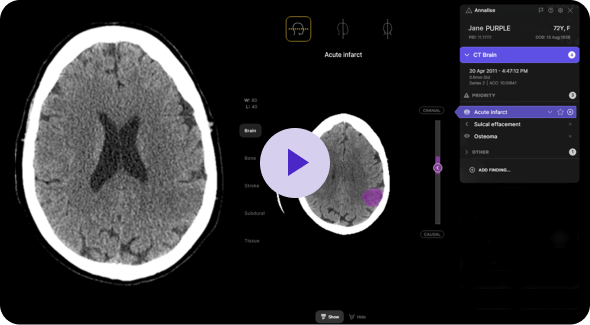Author: Dr Simon Edelstein, Clinical Consultant
When a radiology practice of any size or type embarks on its decision-support AI journey, there are many key things to consider. These include:
- software performance
- ease of use
- reliability
- digital footprint
But paramount to all these is whether, and how effectively, the product will assist the radiologist. Importantly, does it detect just a single pathology, or is it capable of detecting multiple abnormalities?
The benefits of comprehensive vs. single solutions
To explore how a comprehensive solution can better assist radiologists, let’s look at some anecdotal cases involving CT brain studies.
Acute haemorrhage
Several products can detect the presence of acute haemorrhage, with significant benefit in emergency and trauma settings and acute stroke centres. However, a comprehensive product that detects multiple forms of haemorrhage provides additional information, such as findings that may mimic a stroke clinically, as well as multiple other acute and non-acute pathologies, assisting radiologists in all facets of their study analysis.
Post-traumatic brain bleed
If a radiologist detects a small post-traumatic brain bleed, the patient may be observed for a few days and discharged home when stable. However, a radiologist may miss a small mass in the parotid gland (incidental and easily resectable at that stage) due to the satisfaction of search bias, and the lesion’s location on the field of view margins. This mass would be detected by a comprehensive AI product. Although not acutely relevant, it could slowly grow into a larger mass with nerve invasion, requiring disfiguring surgical resection with high morbidity.
Another patient with head trauma and a small brain bleed, with short-term altered consciousness levels and inability to communicate coherently, may have dislocated mandibular heads. If these are missed by the radiologist on the CT brain study, the patient recovers, but is left with chronic pain syndrome and jaw dysfunction. This poor outcome could have been prevented by AI detection with a comprehensive product.
Melanoma
A patient with melanoma was scanned because they were dizzy. Their brain appeared normal, but the radiologist missed a small melanoma metastasis in the orbit. This was detected by an AI product, allowing early vision-sparing treatment rather than orbital exenteration.
Advantages of a comprehensive AI product for large radiology practices
At a large, multisite radiology practice that may have outpatient centres and contracted hospital sites, AI product selection committees should consider the value AI can deliver to their radiologists. Why have AI to only assist with detecting a CT brain stroke or bleed, for example, as opposed to multiple acute and chronic pathologies?
At large practices, even if almost all pathologies are detected on individual cases, a large radiologist cohort reporting on a massive number of cases collectively will miss some findings (whether very subtle, peripheral to the main problem or otherwise) over time.
Although certain findings are not urgent, this does not render them insignificant. This is a major advantage of a backup system for both urgent and non-urgent findings, which may later become very relevant to the patient’s health.
A comprehensive product can also assist large practices with risk management. Increasingly, incidental but overlooked radiology findings that are discovered to have progressed on later scans are resulting in legal action. This has implications for insurance costs.
Moreover, most large practices, especially those that contract for external sites such as hospitals and after-hours teleradiology, are required to manage peer review and quality control (QC) systems. Comprehensive AI products are a backup for most findings and sensitivity/specificity can be altered depending on what is discovered in peer review and quality assurance programs.
A customisable solution can meet your practice’s unique needs
Comprehensive AI products need not be all things to all radiologists in one unchangeable form. Ideally, AI products should be customisable to the setting in which they are used and by whom. For example, some practices and teaching institutions may choose to divide findings into urgent and non-urgent categories or priority levels.
A customisable solution gives radiologists and their practices choice about which findings to display, depending on what is most suitable. For instance, a practice may use peer review and quality control data to determine that certain radiologists may benefit from comprehensive AI model assistance to reinforce incidental findings.
Real world solutions for today’s radiologists
As radiologists, our miss rates, although impressively small, have not changed significantly in the last 50 to 60 years. Imaging technology has evolved substantially over this time, generating scans that are increasingly detailed and complex. Meanwhile, the human brain has not evolved to any tangible degree, yet we need to look for and detect more. Superimposed upon this issue are cognitive biases, tiredness, increased work pressures in this era of a worldwide radiologist shortage, and other distractions.
There is also one “elephant in the room” when it comes to utilising AI. That is, when a radiologist reviews a scan, do we detect one finding, lose interest, stop looking and move to the next case? Or do we aim for a comprehensive assessment of the patient’s scan, pointing out not only what is acutely relevant, but also any additional findings that may be relevant in future?
Why corral our radiology practice into limited AI augmentation? In our pursuit of imaging excellence, comprehensive AI can offer us so much more.
